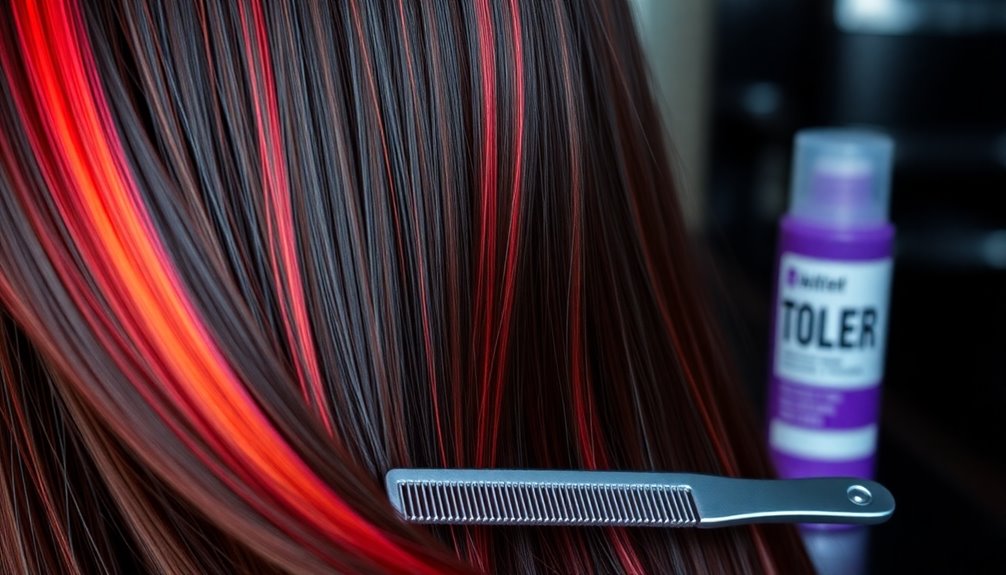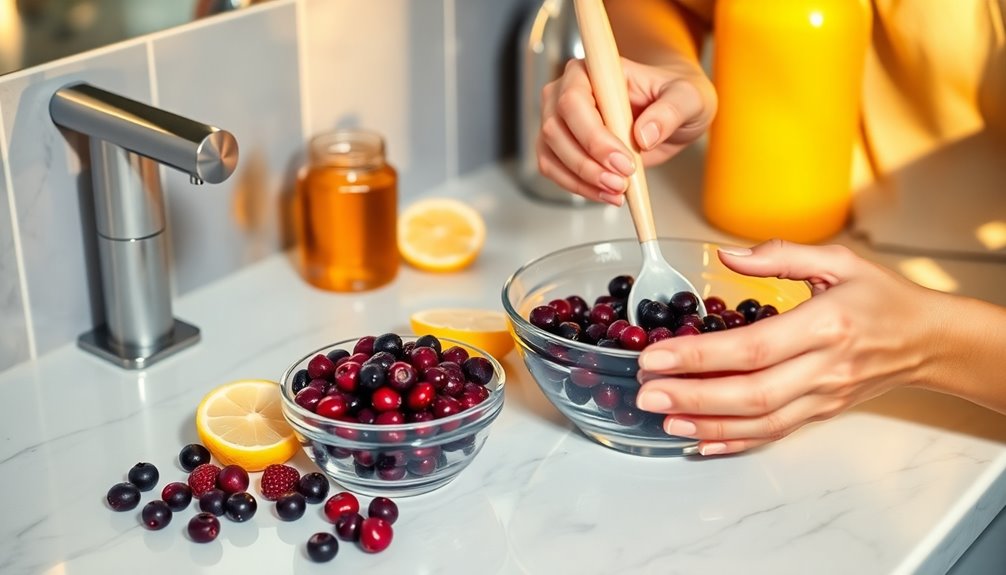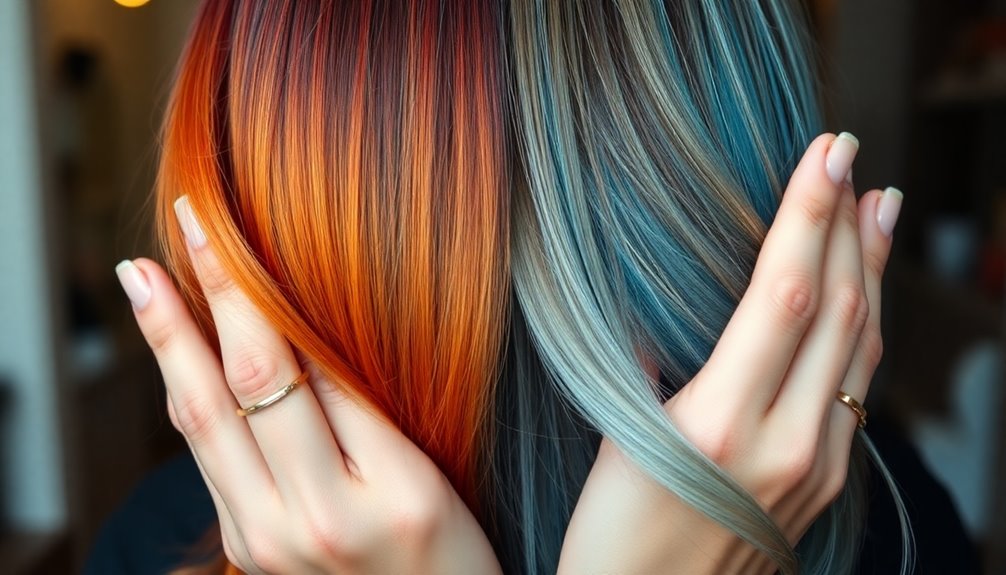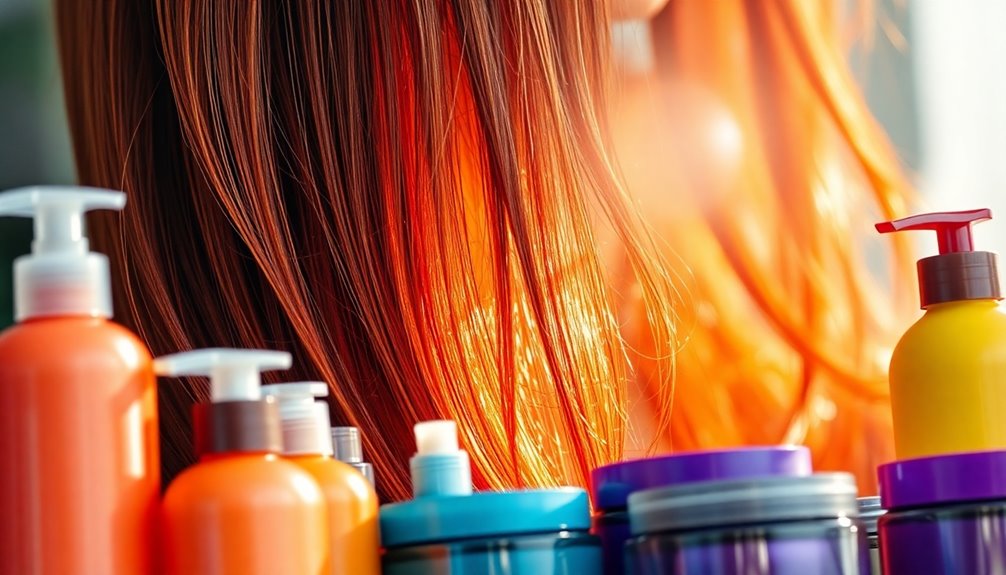Dealing with red and orange discoloration in your hair can be frustrating, but you can fix it! Start by using blue shampoo to neutralize those brassy tones. Don't forget professional toning treatments and UV protectants to maintain your desired color. Regularly conditioning with sulfate-free products keeps your hair healthy and vibrant. If you want even more tips and effective solutions, stick around for additional strategies to restore your hair's beautiful hue.
Key Takeaways
- Use blue shampoo regularly to neutralize brassy orange tones effectively by leveraging the color wheel principles.
- Consider professional toning treatments with experienced colorists to target stubborn red and orange pigments accurately.
- Apply UV protectant sprays before sun exposure to prevent oxidation that can worsen discoloration.
- Incorporate moisturizing conditioners alongside toning shampoos to maintain hydration and hair health.
- Explore home remedies like apple cider vinegar rinses or purple shampoo to combat unwanted hues naturally.
Understanding the Causes of Red and Orange Discoloration

When you bleach or lighten your hair, the underlying warm pigments can become more visible, leading to unwanted red and orange tones. This is particularly common with darker hair shades, where the process of bleaching removes the natural color but can leave behind those pesky orange hues if not done thoroughly.
Additionally, hard water with high mineral content can contribute to brassy tones, as it oxidizes your hair and intensifies warm pigments over time. Exposure to UV rays further accelerates this oxidation, making previously neutralized colors appear brassy and revealing more red and orange tones.
To combat this, regular maintenance and the right toning products can help counteract and prevent the emergence of these unwanted discolorations.
The Role of Bleaching in Hair Color Changes

Bleaching plays an essential role in changing your hair color by breaking down natural pigments.
When you lighten your hair, you might expose underlying warm tones, like red and orange, which can sometimes lead to brassiness.
It's important to be mindful of the risks of over-bleaching, as it can damage your hair and result in undesirable colors.
Impact of Bleaching Process
As you lighten your hair, the bleaching process removes natural pigments, which can reveal underlying warm tones like red and orange. This often leads to an unwanted brassy appearance, especially if you didn't bleach thoroughly.
If you're working with darker hair, orange tones can become more prominent after reaching levels 5-7.
To combat these effects, consider the following:
- Insufficient bleaching can leave dominant orange pigments.
- Oxidation from sunlight can worsen color.
- Toning products are essential for neutralizing brassiness.
- Regular maintenance helps keep your desired shade.
- Choose the right toning product for your hair type.
Underlying Pigment Exposure
While lightening your hair, you expose the underlying pigments that can greatly affect your final color. When you bleach your hair, especially if you have darker strands, you might notice the emergence of orange pigments.
If you don't achieve the desired lightness, those dominant orange tones can create unwanted brassiness. This is particularly true for dark hair, which holds more warm undertones.
Over time, exposure to UV rays and environmental factors can further oxidize your hair, leading to more brassiness.
To effectively neutralize the orange, consider using a toning shampoo with blue or purple pigments. These products can help counteract those warm hues and maintain a more balanced, beautiful color after your bleaching process.
Risks of Over-Bleaching
The allure of achieving a lighter hair color can be tempting, but the risks of over-bleaching often outweigh the benefits.
Over-bleaching can lead to significant hair damage, stripping away natural moisture and oils. This makes your hair brittle and prone to breakage. Additionally, each session lifts the hair cuticle, increasing porosity and susceptibility to environmental harm.
You may also end up with uneven color, leading to unwanted brassy tones.
Consider these risks before you bleach:
- Increased brittleness and breakage
- Uneven color results
- Scalp irritation and sensitivity
- Difficulty maintaining hair health
- Need for intensive hair care
Ultimately, prioritize your hair's condition to avoid the pitfalls of over-bleaching.
How to Neutralize Unwanted Tones With Blue Shampoo

If you're struggling with unwanted orange tones in your hair, blue shampoo can be your best friend.
By understanding color wheel principles, you can effectively counteract those brassy hues.
Plus, mastering the right application techniques and choosing recommended products will help you achieve and maintain a beautiful, cool tone.
Color Wheel Principles
Understanding the color wheel can make a significant difference when you're trying to neutralize unwanted tones in your hair. The color wheel shows that blue is opposite orange, which is why blue shampoo is so effective against brassy, orange tones.
By using blue shampoo, you deposit blue pigments that counterbalance those warm undertones and help maintain a cooler shade.
- Blue shampoo neutralizes brassy tones.
- Regular use prevents orange tones from resurfacing.
- Products like Redken Color Extend Brownlights target brunette hair.
- Consistency is key for ideal results.
- Incorporate blue shampoo into your hair care routine.
Additionally, embracing spiritual guidance can enhance your confidence in your hair journey and overall well-being.
With these principles in mind, you'll be well on your way to achieving a beautifully balanced hair color!
Application Techniques
To effectively neutralize unwanted orange tones, you'll want to dive right into the application of blue shampoo. Start by applying it generously to your wet hair, guaranteeing even coverage.
Leave it on for 3-5 minutes; this allows the blue pigments to penetrate your hair and tackle that brassy discoloration. Depending on how much brassiness you're dealing with, use blue shampoo once or twice a week for best results.
After rinsing thoroughly, follow up with a moisturizing conditioner to keep your hair hydrated and prevent dryness from the color-correcting process. For enhanced effectiveness, consider using a blue conditioner alongside the blue shampoo to guarantee a consistent, even application throughout your hair. Additionally, keeping your hair hydrated with moisturizers is essential to maintain its health and shine during the color correction process.
Recommended Products
When it comes to neutralizing unwanted orange tones in your hair, choosing the right blue shampoo is essential. These products are formulated with blue pigments that effectively combat orange hair, making them a must-have for anyone with color-treated hair.
For best results, look for a shampoo that you can leave in for a few minutes to allow the pigments to work their magic. Here are some recommended options:
- Redken Color Extend Brownlights
- Joico Color Balance Blue Shampoo
- Matrix Total Results Dark Envy
- Fanola No Orange Shampoo
- Paul Mitchell Platinum Blonde Shampoo
Pair your blue shampoo with a sulfate-free conditioner to maintain hair health and extend color longevity.
With the right products, you can keep your hair looking vibrant and brass-free!
Effective Toning Techniques for Color Correction

If you're struggling with unwanted red or orange tones in your hair, effective toning techniques can help restore balance and achieve your desired look.
Toning shampoos, especially those with blue or purple pigments, are your best friends for color correction. They work by neutralizing unwanted hues through the principles of color theory. Regular use of these products can prevent brassy tones from reappearing and maintain your desired hair color over time.
For stubborn discoloration, consider visiting a salon for professional toning treatments, as they target warm tones more effectively.
Additionally, hair glazes or glosses can enhance shine while neutralizing brassy colors, giving you both healthier-looking hair and a beautiful shade. Essential oils for aromatherapy can also be incorporated into your hair care routine for added benefits.
Just remember to wait a week or two before reapplying bleach post-toning.
Recommended Products for At-Home Color Maintenance

Maintaining your hair color at home can be simple and effective, especially with the right products in your arsenal.
To keep brassy tones at bay, consider these must-haves:
- Blue shampoo, like Redken Color Extend Brownlights, to neutralize unwanted orange and red pigments.
- Sulfate-free shampoos, such as Color Extend Magnetics, to promote hair health and prolong your color.
- Silver shampoo and conditioner, like Maria Nila's Sheer Silver series, for keeping blonde shades cool and brass-free.
- Color-depositing conditioners that add temporary pigment, helping maintain your desired shade.
- Color-protecting products with UV filters to shield against sun damage and oxidation.
With these products, you can effectively maintain your gorgeous color between salon visits!
Professional Solutions for Stubborn Brassiness

For those dealing with stubborn brassiness that at-home products can’t tackle, professional solutions can make a significant difference. Many individuals find that salon treatments, such as professional toners and color corrections, can effectively neutralize unwanted warm tones. These services are tailored to each person’s hair type and color, ensuring a customized approach that yields the best results. For more information on how to achieve the perfect tone, shocking contact information revealed is available through local salons that specialize in color correction.
Salons offer toning services using blue or purple toners that effectively neutralize brassy tones, balancing out unwanted warmth. Experienced colorists can assess your hair's health and recommend a tailored approach, often incorporating professional bleaching techniques for controlled lightening. This method helps achieve your desired shade while addressing underlying brassiness.
Additionally, specialized color removers can target and eliminate stubborn red and orange pigments, restoring a more neutral base for further coloring. Demi-permanent gloss treatments can also refresh your color and reduce brassiness, providing subtle correction without permanent changes. Furthermore, the use of integrated techniques in hair care can enhance overall hair health and appearance, leading to better outcomes.
Trusting a professional can lead to the best results in your hair transformation journey.
The Importance of UV Protection for Hair Color Longevity

To keep your hair color vibrant, protecting it from UV damage is essential.
UV rays can cause unwanted orange and brassy tones, especially in color-treated hair.
UV Damage Prevention Strategies
While enjoying the sun can be tempting, UV rays can wreak havoc on your hair color. They accelerate oxidative damage, leading to brassiness and fading, especially in color-treated hair.
To protect your vibrant locks, consider these strategies:
- Use UV protectant sprays before heading outdoors.
- Wear hats or scarves for added physical protection.
- Choose hair care products with UV filters regularly.
- Limit sun exposure during peak hours.
- Stay hydrated to maintain hair's natural moisture.
Protective Hair Products
Using protective hair products is essential for maintaining the vibrancy of your color-treated locks. UV rays can quickly accelerate oxidation, causing brassy tones and fading your stunning hue.
To combat this, apply UV protectant sprays or choose hair care products with built-in UV filters. These specialized products shield your hair from harmful sun exposure, greatly extending the life of your color.
Regularly incorporating these protective hair products into your routine can prevent color fading and enhance hair health over time.
Don't forget, wearing hats or scarves when outdoors adds another layer of protection against color degradation.
Prioritizing UV protection in your hair care regimen is vital for keeping your locks looking fresh and vibrant.
Routine Sun Exposure Tips
How often do you think about the impact of sun exposure on your hair color?
Regular exposure to UV rays can lead to fading and unwanted brassy tones. To keep your hair vibrant, it's vital to incorporate UV protection into your routine.
Here are some essential tips:
- Use a UV protectant spray before heading out.
- Opt for hair care products with built-in UV filters.
- Wear hats or scarves for added protection.
- Limit direct sun exposure, especially during peak hours.
- Schedule regular deep conditioning treatments.
Home Remedies to Combat Red and Orange Tones

If you're dealing with pesky red or orange tones in your hair, several effective home remedies can help restore balance and enhance your color.
First, try an apple cider vinegar rinse, mixing equal parts with water to tone down brassiness.
You can also use a green shampoo to neutralize those unwanted orange hues, as green counteracts red on the color wheel.
For a deeper treatment, create a baking soda paste and apply it to the affected areas for 10-15 minutes before rinsing.
Incorporating purple shampoo into your routine once a week can help combat yellow and orange tones by depositing purple pigments.
Finally, a chamomile tea rinse can lighten your hair gradually while adding shine. Additionally, be cautious when using essential oils in your hair care routine, as some can be irritating or require proper dilution for safe application.
Tips for Maintaining Vibrant Hair Color Post-Treatment

To keep your hair looking vibrant after treatment, it's essential to adopt a diligent maintenance routine. Start using sulfate-free shampoos and conditioners specifically designed for color-treated hair.
Incorporate toning shampoos with blue or purple pigments to neutralize unwanted brassy tones. Protect your hair from UV rays by applying UV protectant sprays or wearing hats when outdoors.
Here are some tips for maintaining your color:
- Use sulfate-free shampoo and conditioner.
- Incorporate toning shampoos weekly.
- Limit exposure to chlorinated pools and saltwater.
- Apply UV protectant when in the sun.
- Schedule regular salon visits for touch-ups.
When to Seek Professional Help for Hair Color Issues

Maintaining vibrant hair color can sometimes lead to unexpected challenges, especially when dealing with unwanted red or orange tones.
If you've tried at-home color correction methods twice without success, it's time to seek professional help. Persistent discoloration, particularly after bleaching, can signal underlying damage that needs expert assessment to prevent further breakage.
Professionals possess advanced color correction techniques and specialized products designed to neutralize unwanted hues while preserving hair integrity. If your hair feels overly porous or sensitive from previous treatments, consulting a stylist can guarantee you receive the right care and products to restore its health.
Regular salon visits for maintenance can also help prevent the buildup of undesirable tones and keep your hair looking its best.
Frequently Asked Questions
How to Fix Red Hair That Turned Orange?
To fix red hair that turned orange, start by using a blue shampoo. The blue pigments neutralize those unwanted orange tones.
Wait about 1-2 weeks before re-bleaching to avoid damage, aiming for a yellow tone while lightening.
You can also apply a medium ash blonde dye to cool down the color. Incorporating glazes or glosses can help with brassiness and shine.
For a longer-lasting solution, consider dyeing your hair a cooler shade.
What Cancels Out Reddish Orange Hair?
Imagine your hair as a canvas, splashed with unwanted fiery hues. To cool those vibrant reds and oranges, you'll want to grab some blue shampoo. Its pigments work like a cool breeze, calming the warmth.
You can also use a medium ash blonde dye to introduce cooler undertones. Don't forget about toning treatments with purple or blue pigments—they're like an artist's brush, smoothing out the brassiness for a balanced look.
How to Remove Red Orange Tones From Hair?
To remove red and orange tones from your hair, start by using blue shampoo, which neutralizes those unwanted warm shades.
You can also apply a toner with violet or ash-based pigments to help balance the color.
If the brassiness is significant, consider dyeing your hair a darker shade with ash undertones.
Finally, maintain your color with specialized color-depositing shampoos or conditioners to prevent the reappearance of those tones over time.
How to Fix Orange Hair After Bleaching at Home?
If you've bleached your hair and it turned orange, you can fix it at home without a salon visit.
Imagine this: using a blue shampoo, you neutralize those warm, brassy tones.
Apply a toning treatment to balance out the color, or consider a darker dye that matches your natural shade.
Allow your hair to rest for 1-2 weeks before re-bleaching.
Finally, use sulfate-free products to keep your color vibrant and prevent future issues.
Conclusion
In the journey to vibrant hair, battling red and orange tones can feel like maneuvering through a stormy sea. But with the right tools and techniques, you can steer your ship toward a brighter horizon. Embrace the power of toners, protect your locks from UV rays, and don't shy away from seeking professional help when needed. Remember, your hair is your canvas, and with a little care, you can paint the masterpiece you've always dreamed of.









